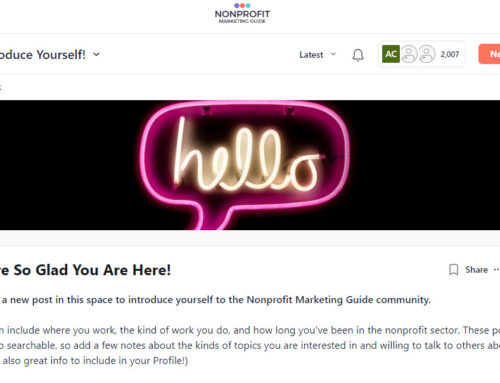I woke up this morning and saw a tweet from Drew at Throwing Light, asking me if I ever deal with information overload. In his own post today, Drew talks about how he blames all the blogs he wants to read for his recent creative slump and explains what he did to overcome. Since I was debating what I wanted to blog about today, I’m seizing this chance to answer Drew’s question. It’s such a common question from nonprofits too that I have several slides on it in my social media presentations.
 The first step is to accept that there is waaaaay more good information out there than you can possibly absorb. The second step is to realize that there is no great public punishment coming your way if you don’t absorb it. In fact, as Drew learned, if you try to absorb it all, your punishment is much more likely to be self-inflicted, like Drew’s creative slump.
The first step is to accept that there is waaaaay more good information out there than you can possibly absorb. The second step is to realize that there is no great public punishment coming your way if you don’t absorb it. In fact, as Drew learned, if you try to absorb it all, your punishment is much more likely to be self-inflicted, like Drew’s creative slump.
Then what?
For me, it comes down to two strategies: the Lists and the Lottery.
The Lists
Spend a little time upfront creating lists that help you see the people who history tells you are most likely to having something good to say in the future. I use a custom page at Alltop to keep track of my favorite blogs. I use multiple lists within Twitter and Facebook (both public and private), and columns within Hootsuite (partner link), to parcel out various people and topics. Within those lists, I have a few must-reads (or my primary lists) and everything else (the secondary lists).
Now, list-making in and of itself can consume enormous amounts of time if you let it. Don’t. As you happen across various people who make you pause or think or laugh, add them to a list. Also add people who are good sorters of information themselves. A person may not have all that much original to say themselves, but if they are a good curator or editor, they are just as valuable to me, because they bring really good stuff to my attention that I would have missed otherwise. Don’t feel like you have to categorize every single person you follow on Twitter. That was an early mistake of mine, and I’ve let that go.
I look at these lists first thing in the morning, along with my email box, not because I think it’s the single most important thing to do in the morning, but because it’s an easy task for my sleepy brain to accomplish. I’m not a morning person. I also do it on my Droid X, which is helpful in two ways: first, because I’m usually still slumped in the big comfy chair in my living room, and two because that little screen forces me to look at just one thing at a time — no dozen tabs open at once like on the PC.
 I try to take another peek at the must-reads twice more during the day, usually as a mental break in between blocks of my own work. This is where my tagging strategy becomes really important, because I don’t want to get sucked into having to absorb everything at the first moment I see it. This time is meant to be a break, not a whole task itself.
I try to take another peek at the must-reads twice more during the day, usually as a mental break in between blocks of my own work. This is where my tagging strategy becomes really important, because I don’t want to get sucked into having to absorb everything at the first moment I see it. This time is meant to be a break, not a whole task itself.
When I do come across something like a blog post that piques my interest, I rarely read the whole thing right then. Instead, I usually tag it. I’m transitioning from Delicious to Diigo for this, but the idea is that I somehow label it so that when I really am ready to think about that topic in more depth, I can go back and actually read it then and think about it.
The Lottery
This is where those secondary lists come in. If I have a few minutes here and there during the day, I go look at those other lists that are interesting, but not musts. I think of it as playing the lottery. Sometimes this skimming produces nothing; other times it produces really great stuff. Others like Beth Kanter call this leaving room for serendipity (which does sound a lot nicer than playing the lottery). Beth says she’ll be blogging a lot this year about social media time management, so keep Beth on one of your lists!
This is not a perfect process. I’m sure I do, in fact, miss some stuff I wish I had seen. And sure enough, I still end up seeing a lot of things that are completely useless. But overall, I feel like I am seeing enough to keep up with the people and topics that I want to keep up with, and just enough of everything else to allow for some pleasant surprises.
Most importantly, this process lets me get stuff done. I believe I strongly benefit from reading what others are thinking and doing. This morning, and this blog post, are a perfect example. If Drew hadn’t tweeted me about his post, I wouldn’t have written this one today.
You also need to do exactly what Drew did, which is to find that thing — whatever it is — that sets your mind free for awhile. For Drew it was taking pictures of snow-covered statues in downtown Philadelphia. For me it’s often curling up on the couch with a pen and paper in my hand. It’s extremely rare for me to get a brilliant idea at the computer. They almost always come when I’m curled up comfortably somewhere, taking a hot shower, or working out. I know that about myself, so when I’m stuck, I do one of those three things.
It’s your turn. How do you deal with information overload, and what do you do to ensure that you don’t let it bury your own creativity? Please share in the comments.






